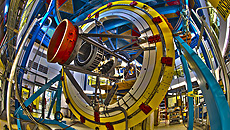The Dark Energy Camera opens its eyes
 |
A long-awaited device that will help unravel one of the universe's most compelling mysteries gets ready to see first light.
|
On a hot June Illinois afternoon, a celebratory atmosphere prevails at Kuhn Barn, a holdover from Fermi National Accelerator Laboratory's agricultural past and also a popular cookout spot.
Doctoral student Guillermo Moroni works the grill, proudly serving lamb chops and hamburgers to his scientific collaborators—other postdocs, technicians, scientists and graduate students. The smell of roasted corn floats across picnic tables littered with cakes, pies and brownies.
The gathering is more than a simple celebration of the start of summer; it marks a tipping point. The Dark Energy Camera, the first device specifically designed to search for dark energy, is on the brink of completion. Project manager Brenna Flaugher—who organized the cookout—and her colleagues are about to see the project they've been preparing for the past eight years transition from dream to reality.
This fall, scientists will fire up DECam, as it's affectionately known, on a mountaintop in Chile and see their hard work pay off.
"It's going to be very exciting for all of us to open the shutter for the first time," Flaugher says. "Who knows what we'll see?"
What they hope to see are signs of the invisible, mysterious force that seems to pull the universe apart—a force that has never been directly observed.
Physicists have known about cosmic expansion since the 1920s, when Edwin Hubble found that the light spectrum of distant objects was shifted to higher wavelengths in a phenomenon called redshift. But dark energy has been on their minds only since 1998, when two independent studies of type 1a supernovae revealed the bright, exploding stars to be fainter than expected, hinting that the expansion of the universe is speeding up. Scientists previously thought that, under Einstein's Theory of General Relativity, the expansion of the universe would slow as time went on due to the pull of gravity. The 1998 finding suggested otherwise.
It seems that about 5 billion years ago, the universe started expanding at an accelerating pace. Before that, gravity had been the dominant force in the universe, but then something else took over, relentlessly pushing parts of the cosmos away from one another. Theorists postulate that if we really understand how gravity works, then some unforeseen, invisible force—a dark energy—must be responsible.
"The universe was matter-dominated when it was slowing down," Flaugher says. "And then this slowing down stopped—and now we're in a dark-energy dominated universe because the expansion is winning over the gravitational pull of everything."
Read more
—Joseph Piergrossi
|